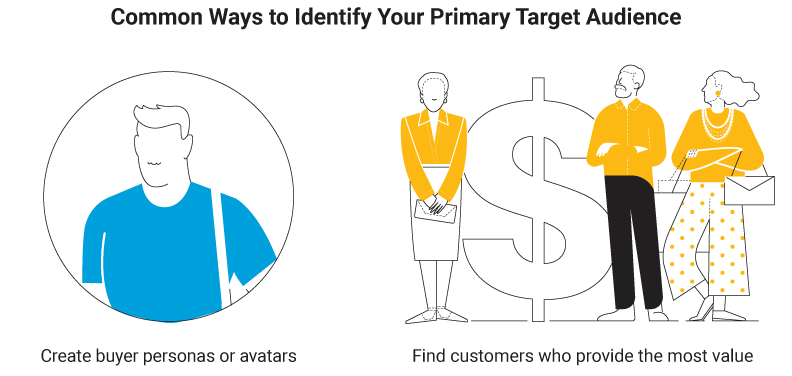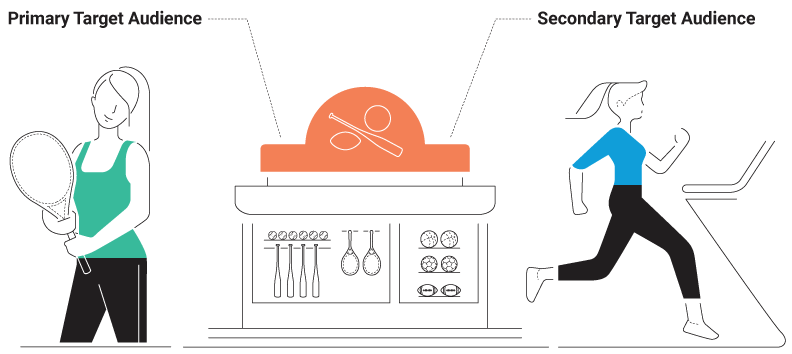Not every person on the planet is going to want to buy from you. And that’s okay! When it comes to marketing, the key isn’t selling to everyone but instead selling to the right one.
Identifying and marketing to your target audience is one of the best ways to add customers to your pipeline while increasing your company’s bottom line.
The question is: Who is IN the right audience? And once you figure that out, how do you market to them?
Below, you’re going to find out how to reach the right people and make meaningful connections when you do.
What is a primary target audience?
A primary target audience is the group of people that your business or organization most wants to reach with its products, services, or message. This audience is often the one that will generate the most revenue or have the most impact on your organization’s goals.
Businesses typically segment their audiences into different groups based on factors like age, gender, income, location, interests, and more. Once these segments have been identified, businesses can then start to identify which one is their primary target audience.
There are a number of ways to determine who your primary target audience is. One common method is to create buyer personas or avatars. These are fictional representations of your ideal customer based on real data about your existing customers.
Another way to identify your primary target audience is to look at your current customer base and see which group is providing the most value to your business.

Once you’ve identified your primary target audience, you can start tailoring your marketing messages and strategies to appeal specifically to them.
How is a primary target audience different from a secondary target audience?
It’s important to remember that your primary target audience won’t always be the same as your secondary or tertiary audiences. As your business grows and changes, so too will your target audience. It’s important to regularly revisit who you’re trying to reach so that you can ensure you’re always connecting with the right people in the right way.
So, while your primary target audience is the group of people you most want to sell your products or services to, your secondary target audience is a group you also want to sell to—but to a lesser extent. The most important difference between the two audiences is that the primary target audience is more important to the company’s success as far as lead generation goes.
The reason a company has a primary target audience is because that group is more likely than any other to be interested in what the company has to offer. They’re also more likely to buy what the company is selling. For these reasons, the primary target audience is the most important group for a company to market to.
That said, a secondary target audience may also be interested in what the company has to offer, but they’re not as likely to buy from the company as members of the primary target audience are. This doesn’t mean that companies shouldn’t market to secondary audiences; they just have to keep in mind that their efforts may not produce as much in revenue.
To identify a secondary target audience, one can again look at who buys the product or uses the service, but this time also consider who else might be interested in it. Additionally, one can look at who might be influenced by the advertising message even though they are not directly targeted.
To better explain the difference, here’s an example: Picture a company that makes sports equipment. Their primary target audience would be people who are actively involved in sports. Their secondary target audience would be people who are interested in fitness or health, but don’t necessarily participate in sports. The company might use different marketing strategies to reach these two groups of people.

How do I market to my target audience?
Once you understand who your target audience is, you can then begin to create marketing campaigns and messages that are specifically tailored to them.
This can include using specific language, images, and tones that will resonate with your target audience and help to get your message across in a way that they will understand and appreciate.
Additionally, it’s important to consider where your target audience can be found, and then make sure that your marketing efforts are reaching them where they are. By taking all of these factors into consideration, you can develop a well-rounded marketing strategy that will reach your target audience effectively and help you achieve your business goals.
Some ways you might consider marketing to your target audience includes:

Blogging
This form of content can be short and sweet or lengthy and informative. Blog posts can be several hundred words or upwards of a few thousand, but they’re structured as a single page that’s scrollable so users can find the information they need. Many blogs allow for engagement—comments or feedback—from readers. Like a website, blogs are updated more frequently than other types of written content, but are great for building your audience email list or establishing yourself as an expert within your industry.

Email Marketing
This is a must-have for any business and an easy way to remain top-of-mind with prospects and existing customers. Helping you to stay connected to your customers, you can easily create professional-looking email promotions that talk about your products, services, and more.

Direct Mail Marketing
Direct mail campaigns can serve a lot of purposes. You want to make sure you know what your sales and marketing goals are before you get started. The good news is that no matter what you’re trying to accomplish, direct mail campaigns can be tailored for your needs. From new businesses looking for more brand awareness to established organizations looking for potential clients, direct mail has the ability connect with your audience with quality products like postcards, brochures, flyers and letters.

Social Media
There are many free social media platforms to choose from. Whatever kind of content you create, social media can help you share your message with your target audience. If you enjoy blogging, for example, share full-length blog posts on sites like Facebook. Meanwhile, a site like Instagram is best suited for images and video content.

Online Advertising
With online display ads, you can place your brand and message on websites that your prospects already visit. From promoting new products and services to reminding existing customers that they can expect a great experience when they visit your website, it’s easy to make connections and grow your business through this intuitive marketing channel.
As a business owner, it’s important to identify and market to your primary target audience. By doing so, you’ll be able to better focus your marketing efforts and resources, and ultimately see more success.
Keep in mind that your target audience may change over time, so it’s important to revisit your buyer persona on a regular basis to make sure you’re still on track. With a little effort, you can ensure that all of your marketing efforts are focused on the right people, which will lead to better results for your business.
Once you determine who your primary customers are and where they are most likely to be found (online or offline) you can reach them with your marketing message.






